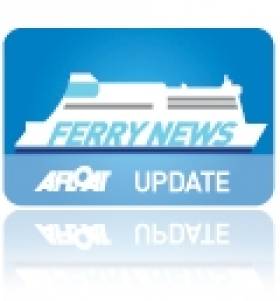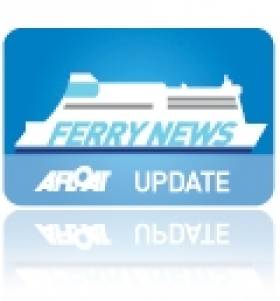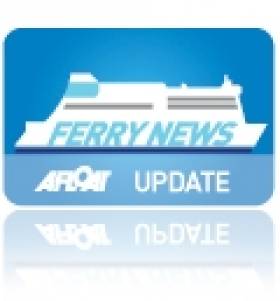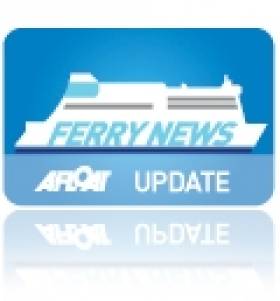Displaying items by tag: Brittany Ferries
Not Just ‘Any’ Ferry Funnel As Flagship to Undergo 'Scrubbing'
#FerryScrubbers - Pont-Aven operated the final Cork-Roscoff round trip sailings last weekend with the Brittany Ferrries flagship scheduled to reopen the seasonal service in April 2016, writes Jehan Ashmore.
Saturday’s sailing also marked the last Irish-France crossing of the 2,400 passenger /650 cabin cruiseferry before the 41,748 tonnes ferry’s funnel are to be installed with 'scrubbers' this winter. The fitting of scrubbers are a result of new stricter 'green' controls following the EU Low Environmental Low Sulphur Directive that came into effect at the beginning of this year.
Pont-Aven will be unique in that she will be the only ferry operating in Irish waters during 2016 fitted with the sulphur emission scrubbers. This is due to the fact that the ferry also plies on the Roscoff-Plymouth route in the English Channel, one of several geographical zones that are under the EU directive to curb on emissions.
The Irish Sea nor surrounding waters are part of such a sulphur zone, SECA (Sulphur Emission Control Area). In addition to the English Channel, the other SECA zones include the North Sea and the Baltic.
Work to install the emission reduction technology on the 2004 German built Pont-Aven are understood to take place early next year at the Astander shipyard in Santander. The installation of scrubbers are essentially gas filters which allow the ferry to burn cost-effective heavy fuel oil, whilst still complying with new, stringent regulations applying to ships' emissions.
The Spanish port is also where the Pont-Aven serves a regular service to Plymouth.
So far the majority of Brittany Ferries fleet have undergone work to fit scrubbers, as briefy referred in Afloat, notably in the case of Normandie last year. It transpired following her return to the Caen (Oustreham)-Portsmouth route, the alteration of the funnel's appearance was rather boxy.
As for Pont-Aven, it will be interesting to see if the modifications carried out, albeit important, do not overwhelming detract from what is an overall attractive looking ferry.
The latest fleetmate currently receiving scrubbers is Normandie’s route-mate, Mont St. Michel. Likewise, the work is been currently carried out in Santander and is due to be completed in December.
Mont St. Michel sailings are instead been taken by Armorique, which stood down from her main Roscoff-Plymouth duties. In turn the most western English Channel route services are been maintained by Bretagne. As previously reported on Afloat.ie, Bretagne ended the final 2014 round trip sailings on the seasonal link to Ireland.
Getting into more technical details, a scrubber cleans the ship's exhaust, removing about 90% of the sulphur dioxide, this is to comply with new MARPOL VI limit of 0.1% sulphur emissions. They have the added benefit of removing about 70% of particulate matter which is also harmful to health.
One scrubber is required for each engine, which requires considerably investment, for example Pont-Aven has seven engines (four for propulsion, and three for electrical power). So each will require seven scrubbers.
Approximately, the cost is £10 million per ship - as well as the length of time it takes to install the scrubbers of around eight weeks. Afloat understands that Brittany Ferries are expected to pay more than €31m to complete the programme of installing the scrubbers across almost the entire ferry fleet.
During a recent sailing on board Armorique, a senior crew member commented to Afloat.ie that the 2009 Finnish built ferry will also undergo the work to install scrubbers between January and March.
Returning to the Irish route, Pont-Aven is scheduled to resume seasonal sailing service with the first inbound crossing to Cork on 1 April 2016. The outward return leg departs Ringaskiddy ferryport the next day on 2 April to Roscoff.
Brittany Ferries Season to France Opens from Cork
#BrittanyBegins – Brittany Ferries first Cork-Roscoff season sailing for 2015 took place today as the flagship Pont-Aven departed Irish shores on the Cork-Roscoff service, writes Jehan Ashmore.
Pont-Aven is the French operator's custom-built 41,748 tonnes cruiseferry that features luxury cabins with balconies. The 2,400 passenger /650 cabin vessel also boasts an indoor swimming pool, the only ferry to have this unique facility serving in Irish waters.
This year will be the 36th season of Brittany Ferries on the direct Ireland-France link that was begun by Breton based operator Bretagne-Angleterre Irlande (B.A.I) otherwise known as Brittany Ferries. Since then over the decades the company has continued to grow the service with a range of stylish ferries on the 14-hour route between Munster and Brittany. In addition to running a network of cruiseferry-style services on UK-France routes and services also linking the UK and northern Spain.
It is only since last year that Brittany Ferries have introduced their no frills 'économie' marketed UK sailings on the Portsmouth-Le Havre and Portsmouth-Bilbao routes. This allows passengers to have an option to travel on services with fewer on board amenties while offered at lower-fares.
Due to passenger demand and no doubt competition from former rivals, LD Lines who subsequently closed all their routes last year, Brittany Ferries have responded.
As previously reported on Afloat.ie, the company are to launch a second ship to join Etretat when the no frills concept service is boosted by the launch in May of chartered ro-pax Baie de Seine.
Brittany Ferries Plans to Upgrade LPG Cruiseferries Suspended
#LNGferryOnHold - Brittany Ferries have been forced to suspend plans to upgrade much of its fleet which according to Ships Monthly were to operate on Liquefied Natural Gas and also put on hold construction of an LNG-powered 'Pegasis Project' cruise ferry.
As previously reported on Afloat.ie, the giant 52,000 tonnes LPG powered ferry proposed for the Cork-Roscoff seasonal route in 2017 was also to serve primarily Bay of Biscay services from Portsmouth and Plymouth to Santander in Spain.
Plans to comply with new emissions rules from 2015 included the installation of scrubbers on three ships and the conversion to allow three newer vessels to operate on LNG. The process started on 18 October, when Normandie arrived in Santander for installation of scrubbers.
Work was to start on the €270 million LPG 'Pegasis' – Power Efficient Gas Innovative Ship – at STX Saint Nazaire in 2015, with delivery of the 52,000gt vessel in 2017, but the yard was struggling to fit the ferry into its sequence of cruise ship orders.
To read the full Ships Monthly report, also click HERE.
The Bretagne operated end of season Cork Roscoff sailings just over a month ago and the 14 hour routes usual cruiseferry Pont-Aven is scheduled to reopen services in March 2015.
#BrittanyFerries – Bretagne, Brittany Ferries first custom-built 'cruise-ferry' made a rare call to Cork Harbour's Ringaskiddy Ferry Terminal yesterday, the arrival of the vessel from Roscoff was the first this season which started in March, writes Jehan Ashmore.
Cork-Roscoff sailings are otherwise operated by the larger Pont-Aven (2004/41,746grt), another cruiseferry ordered by the Breton based company which required a vessel to cater for 2,400 passengers in luxurious surroundings and space for 650 cars.
As previously reported, Pont-Aven this season marked her 10th season since introduction on the Ireland-France link replacing Bretagne (1989/24,543grt). Two year's after Pont-Aven's Irish debut, the Bretagne returned to the route for a once-off round trip in 2006 as Pont-Aven was chartered for spectator duties during the yachting spectacle of the Race de Rhum.
Bretagne's normal route is Portsmouth-St. Malo in which sailings are currently covered by Pont-Aven which in addition to running on the Irish link serves Roscoff-Plymouth as well to UK-Spain routes.
The reason for switching vessels is to meet requirements of winter sailings and rosters for each member of the Brittany Ferries fleet to take turns to dry-dock for annual overhauls.
This year, Bretagne celebrates her 25th anniversary since entering service in 1989. The cruiseferry with a capacity for 1,926 passengers and 580 cars is the only member of the Brittany Ferries fleet to have been built in France, when she was launched by Chantiers de l'Atlantique, St. Nazaire. Likewise of Pont-Aven she was commissioned to serve Roscoff-Plymouth, UK-Spain services and operate a once weekly service to Cork.
Bretagne will continue to operate the shoulder season of the Irish service with a further two Roscoff-Cork round trips of the weekend-only operated route. The final sailing from France is on 31 October and from Ireland the last crossing is to take place on 1 November.
The 2015 season starts with the return of Pont-Aven with an outward bound sailing from Cork on 21 March. Sailings take 14 hours on what is the shortest crossing time between Ireland and France.
French Ferry Operator Plays it Part on D-Day 70th Anniversary and Not Just 'APP' Service
#FrenchD-DayFerries- As the eyes of the world will be focused on Quistreham, as previously reported, the French ferryport in northern France will be where the largest 'international' ceremonial event to commemorate the 70th D-Day Anniversary takes place this afternoon, writes Jehan Ashmore.
The allied invasion on 6 June 1944, was the largest amphibious assault ever launched and today's commerorative event (click for live TV coverage 3pm) in Ouistreham is the outer port of nearby Caen.
Royal families, heads of states and governments and world leaders and notably members of G'7' among them German Chancellor Angela Merkel, though Russian President, Vladimir Putin will be attending in his own capacity.
Due to the major event, Brittany Ferries which operates between Ouistreham (on the edge of 'Sword' Beach) and Portsmouth have diverted a scheduled round-trip sailing to Cherbourg instead. The diverted sailing from the UK port by Mont St. Michel is expected to arrive in Cherbourg at 16.00, one hour after the start of the major international commemorative event.
The Normandy port on the Cotentin Peninsula is as previously reported on Afloat.ie, is where the Breton based operator runs a service to the Hampshire port as well as to Poole in neighbouring Dorset.
Portsmouth was one of the key strategic locations across the UK south coast, where thousands of Allied troops left for Normandy 70 years ago and landed on Sword Beach, the easternmost of the five Normandy code-named beaches where more than 150,000 men came ashore. Thousands of men and indeed women were lost in the battle to liberate occupied France.
Fittingly both ports will be marking D-Day events in remembrance and Brittany Ferries which started the Ouistreham ferry service in 1986, is also playing a part by holding on board lectures about the historic World War II event.
For many of its customers, the route to the port which is connected to Caen by the Canal de Caen de la Mer, carries an unmistakeable symbolism as the canal is also the location of the famous 'Pegasus' bridge at Benouville.
Special arrangements have also been made to book veterans aboard its ferries also to Cherbourg and Le Havre as they travel to Normandy during this first week of June to pay homage to lost comrades.To accompany these VIPs, additinal staff at its ports and on board are to welcome and look after them.
Some veterans have chosen to hold special on-deck remembrance ceremonies as they approach the Normandy coast, where Brittany Ferries' captains will reduce speed of vessels to enable wreath-laying ceremonies at sea.
The ferry operator has launched a D-Day APP for more details click HERE and much more.
As for the present day, 900,000 passengers annually take the Portsmouth-Caen route and where 'Sword' beach played such an integral and strategic role compared to the peacetime leisure activities in which we all enjoy freedom and liberty.
This is in absolute stark reality to the critical and momentous World War II event, in which those who fought saw the very same beach for the first and also their last during enemy action. Today we all have the luxury to see the France coast and not merely as a fleeting glimpse!
Brittany Ferries Flagship Cruiseferry Pont-Aven Paints a Picture of Service 10 Years On
#PontAven10years – This day ten years ago Brittany Ferries flagship cruiseferry Pont-Aven, was named in a ceremony, by her Breton owners in Roscoff, from where the luxury vessel sailed last night to Cork Harbour and returns to France this afternoon, writes Jehan Ashmore.
Pont-Aven is named after an attractive small Breton town also known as the 'cité des peintres' as the location drew artists to sketch its picturesque scenery.
Among those drawn to paint scenes of Pont-Aven were Monet and the flagship celebrates the heritage of its namesake through of course it paintings, even boosting among its artwork collection a painting by Gaugin.
She was designed primarily for the UK-Spain market in which she made her maiden voyage from Plymouth to Santander on 24 March 2004, with crowds lining Plymouth harbour to cheer her off.
Further maiden voyages included her English Channel route from Plymouth to Roscoff which included a reception on 27 March. She made her 'Irish' maiden crossing to Cork's Ringaskiddy Ferry Terminal arriving on 2 April. Later that month, on 26 April she was officially named in Roscoff.
A decade on and at 41,700 tonnes, the 184m Pont-Aven, remains an impressive vessel within Brittany Ferries modern fleet. She has a 2,400 passenger capacity and crew of 470 which service the luxurious facilities which can easily be described as cruiseferry standards.
Pont-Aven is unique to any cruiseferry serving Ireland as she features the Finistère indoor swimming pool offering sea-views on a high-deck and with an adjoining bar.
Also among her extensive amenities is Le Fastnet Piano Bar to reflect her Irish trading route connections with her season-only sailing schedule operating to a weekend round-trip from Roscoff to Cork.
Pont-Aven was custom-built for Britanny Ferries by Meyer Werft shipyward in Papenburg, Germany, to serve the UK-Spain market as well to the Breton-Cornwall link between Roscoff and Plymouth.
The western Engish Channel route was Brittany Ferries first route in 1973 with its origins stemming from exporting Breton vegetable produce to the UK market. Since then the company have dramatically expanded to offer gite, cottages, chalets holidays and more.
The Irish service followed five years afterwards and the Roscoff-Cork route is currently the only ferry route from Munster and therefore the longest continous operating service since its inception in 1978.
In addition to the the Irish route, Pont-Aven is kept busy linking three other nations on an intensive schedule. In order to maintain the sailing roster, the 28 knot Pont-Aven can achieve this from an engine power of 50,400 kW and propulsion power of 43,200 kW.
Brittany Ferries Reopen Fast-Craft Seasonal UK-France Service
#BrittanyFerryCraft – Brittany Ferries reopen Portsmouth-Cherbourg seasonal services by Normandie Express, the fast-craft adding another alternative to their English Channel routes among them, as previously reported the new "économie" services to France and Spain, writes Jehan Ashmore.
The first sailing is this afternoon's 17.00hrs (local time) departure from Cherbourg to Portsmouth and which sees the InCAT built 98m Normandie Express craft that takes both cars and foot passengers at high-speed across in only three hours to the UK. She will operate the season with a single sailing daily in each direction up to 9 September.
The first day operating to a full sailing schedule with sailings in both directions will start with tomorrow's UK-France sailing at 09.00hrs and corresponding France-UK sailing departing at 17.00hrs.
The route provides options for passengers travelling from London and the south of England who want to get to France fast.
Arriving in Cherbourg likewise of its UK counterpart, the Normandy port has a long naval history and a large harbour plus marina to explore in addition to an old fishing port. For onward travel, Cherbourg located on the tip of the Cotentin Peninsula has access to the country's extensive motorway network.
Brittany Ferries Launch Season over St. Patrick's Weekend
#BrittanyFerries- Opening Brittany Ferries Cork-Roscoff season is Pont-Aven, the cruiseferry will operate the inaugural round-trip sailing over the St. Patrick's weekend, writes Jehan Ashmore.
As previously reported, last year Pont-Aven completed the 35th season of services on the Ireland-France route that began in 1978 and which was served by the Armorique. This season sees the Pont-Aven enter her 10th season on the 14 hour service.
She sets sail from Roscoff on Friday 14 March and arrives next day at Ringaskiddy ferry terminal, Cork Harbour.
The outbound sailing from Cork departs Saturday 15 March with an arrival in Roscoff the following morning at 07.00hrs.
This leaves plenty of time to reach the French capital should one consider celebrating our national day abroad.
Once again the season continues up to early November.
Brittany Ferries Order Giant LNG Powered Cruiseferry
#NewFerry - Brittany Ferries has announced an order for its largest ever cruiseferry, a 52,000 tonnes giant powered by liquefied natural gas (LNG) and entering service in 2017 on Cork-Roscoff and UK-Spain routes.
The 12 deck cruiseferry with a capacity for 2,474-passengers, 675 cabins and 800 vehicles will be the first such ferry to serve in Irish and UK waters and one of the biggest vessels of its type in the world.
Brittany Ferries' current flagship, Pont-Aven is to move to the Portsmouth-St. Malo route when the 210-metre long newbuild is expected to enter service in late Spring of 2017.
She is to be built by STX France shipyard in St. Nazaire. For the last two years Brittany Ferries and the shipyard have been co-operating for two years on a study regarding the feasibility of powering a cruise-ferry by LNG.
The newbuild will also be the cleanest, most environmentally-friendly ship to operate in UK waters because LNG emits about 25 per cent less carbon dioxide during combustion than marine fuel oil and burns with no smoke. It is entirely free of sulphur and is very low in nitrogen oxide emissions.
Operating on the longer routes between UK and Spain, she will have many of Pont-Aven's features, such as an indoor swimming pool, two cinemas, restaurants, pet kennels, and so on. In addition, she will have 30 pet-friendly cabins which have proved so popular on the operatorsother ship to Spain, Cap Finistère, as well as a quiet reading lounge, an observation area, and a sophisticated spa treatment room with panoramic views. The latest technology will be applied and free Wi-Fi will be available in every cabin and throughout the ship.
Families will be well provided for, with two children's play areas as well as a teenager zone. As you would expect on any cruise ship, entertainment features prominently and there will be 3 stylish bars and a high-tech stage area.
Brittany Ferries already has an enviable reputation for the quality of its ships, as well as its service and cuisine, but this will be further enhanced by some of the luxury features of this new cruise-ferry. For example, each of the Commodore Suites will have its own balcony.
Mike Bevens, Group Commercial Director comments: "This represents a huge investment which will benefit not simply our customers but the environment as well. Unlike other forms of transport, such as aircraft or trains, every one of our ships is different, each possessing its own unique character."
"This addition to our fleet will be no exception, but will incorporate all the best features of our other vessels so as to provide our customers with a truly exceptional experience. No other ferry in the UK will come close to offering this new ship's range of facilities and its launch will mark the beginning of a new era in ferry travel."
Stena Line replaces Former Irish Sea Ferry on Sweden-Poland Route
#BrittanyBaltic – Stena Line are to introduce a larger ro-pax vessel on the Karlskrona-Gdynia route next week with Stena Baltica II, the Brittany Ferries former freight-ferry Cotentin (2007/19,909gt), writes Jehan Ashmore.
The 2,188 lane metre ro-pax Stena Baltica II which as Cotentin ran French-UK-Iberian routes replaces Stena Alegra on the Karlskrona-Gdynia route. The vehicle stern-only loading 'Alegra' of 1,950 lane metres had only began operating in July. She originally entered service as Dawn Merchant in 1999 for Merchant Ferries Dublin-Liverpool service.
Cotentin was built by Aker Finnyards, Helsinki and her return to the Baltic Sea sees the 210 -passenger ro-pax launch the Sweden-Poland route to meet the growing demand for increased freight deck capacity. The 163m long vessel with accommodation for 120 freight-drivers has the ability to load both bow and aft, so-called double tier loading and drive-through on both decks.
Tony Michaelsen, Route Manager Karlskrona-Gdynia said: "We are pleased to have a long-term solution in place that enables us to meet the growing needs of our customers, providing increased flexibility and a greater loading capacity. We have huge demand for capacity on the route and require a third vessel to be able to take care of all the cargo.
Freight volumes between Sweden and Poland have continued to grow. Up to October 2013, freight volumes have increased by 18%, car volumes by 7% and passenger volumes by 9% compared with the same period in 2012.
Michaelsen added, "We expect this trend to continue in the coming years as economic development in Poland and Eastern Europe remains very strong".
Stena Baltica takes over the 'Allegra's schedule by operating three departures a week from Karlskrona and Gdynia. She starts sailings on 24 November with a departure from the Polish port and will operate alongside Stena Vision and Stena Spirit which run regular schedules.
The previous Stena Baltica operated on the same service when the Rosslare-Fishguard ferry Koningin Beatrix was transferred in 2002 to Scandinavia. Her direct replacement Stena Europe currently maintains the St. Georges Channel route. The original 'Baltica' served alongside Stena Nordica which now runs between Dublin Port and Holyhead.







































































